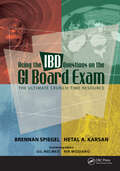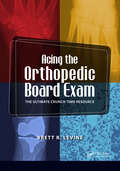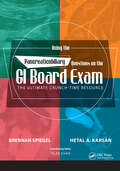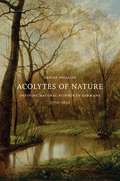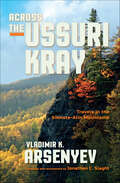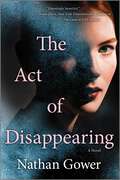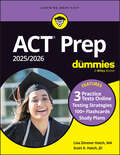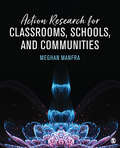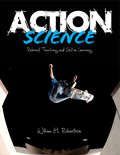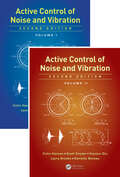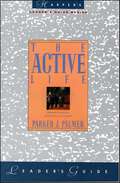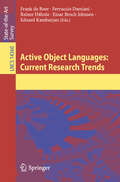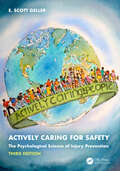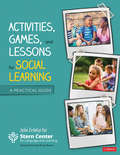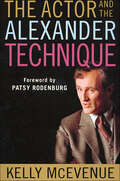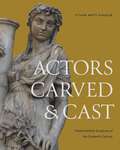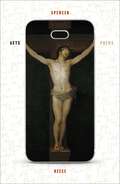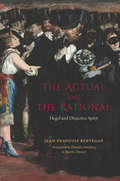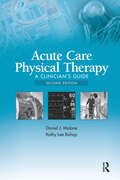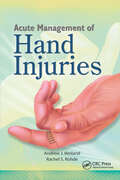- Table View
- List View
Acing the IBD Questions on the GI Board Exam: The Ultimate Crunch-Time Resource
by Brennan Spiegel Hetal KarsanThe world of inflammatory bowel disease (IBD) knowledge is vast. Within that world is a sub-set of knowledge that is especially important for everyday clinical care. And a sub-set of that is testable for the Board exam. The testable material includes time-honored, locked-in-stone, mostly uncontroversial facts that have withstood the test of time. The answer to your study questions (and reduction of your study time!) can be found inside Acing the IBD Questions on the GI Board Exam: The Ultimate Crunch-Time ResourceUntil now, there has been no single, slim, but high-yield volume that summarizes the IBD you really need to know for the board exams, preparing for rounds, or just plain read. The authors have collected every pearl of wisdom, high-yield factlet, IBD "Board buzzword," micrograph, and classic imaging study they could muster, all while keeping Acing the IBD Questions on the GI Board Exam: The Ultimate Crunch-Time Resource a manageable size.In today’s fast-paced world it is hard to keep up with the burgeoning IBD literature. Traditional textbooks usually feature long and detailed discussions that don’t directly address board and recertification exams. On the flip side, many board review manuals provide lists and bullet points lacking sufficient background and context. Acing the IBD Questions on the GI Board Exam by Drs. Brennan Spiegel and Hetal Karsan, fills the unmet need in board review by presenting time-tested and high-yield information in a rational, useful, and contextually appropriate format.Why you need Acing the IBD Questions on the GI Board Exam:• Focuses exclusively on inflammatory bowel disease review• Carefully vetted board-style vignettes with color images• Comprehensive yet succinct answers using a high-yield format• Emphasis on key clinical pearls and “Board Buzzwords”• Rapid-fire crunch time exam with 140 classic one-liners such as:Diarrhea + mucus-filled cysts throughout colon = ?The vastly evolving world of IBD includes genetic breakthroughs and new medications with different risks and benefits. Acing the IBD Questions on the GI Board Exam has it all in one resource that includes endoscopic, histologic, radiologic and dermatologic manifestations, as well as with great images and tables to help guide the reader.Chapters include:• A compilation of general lessons learned from past test takers• “Tough Stuff” board review vignettes• “Crunch-Time” Self-Test—Time to get Your Game On! With its focus on pearl after pearl, emphasis on images, and attention to high-yield “tough stuff” vignettes you don’t know the answers to (yet), Acing the IBD Questions on the GI Board Exam: The Ultimate Crunch-Time Resource will help you ace the GI and recertifying examinations, look good on clerkship rounds, simply challenge you with interesting and entertaining vignettes, and take optimal care of your IBD patients in clinical practice.
Acing the Orthopedic Board Exam: The Ultimate Crunch Time Resource
by Brett LevineIn today’s fast-paced world, orthopedic residents and fellows struggle to find the time to study for the board exams, prepare for the recertification exam, prepare for the Orthopedic In-Training Examination, prepare for teaching rounds, or just plain read. What is the best way to effectively prepare and study, if reading multiple resources can’t seem to fit into your daily schedule? The answer to your study questions (and study time!) can be found inside, Acing the Orthopedic Board Exam: The Ultimate Crunch-Time Resource Until now, there has been no single high-yield volume that summarizes the “tough stuff” on the orthopedic board and recertification exams. Acing the Orthopedic Board Exam: The Ultimate Crunch-Time Resource is meant to give an edge on the really tough questions found on exams, rather than be a simple review of the basics. Why you need Acing the Orthopedic Board Exam: • Carefully vetted board-style vignettes with color images • Comprehensive yet succinct answers using a high-yield format • Emphasis on key clinical pearls and “Board Buzzwords”Acing the Orthopedic Board Exam by Dr. Brett R. Levine fills the unmet need in board review by presenting time-tested and high-yield information in a rational, useful, and contextually appropriate format.Chapters include: • A compilation of general lessons learned from past test takers • “Tough Stuff” board review vignettes • “Crunch-Time” Self-Test—Time to get Your Game On! With its focus on pearl after pearl, emphasis on images, and attention to high-yield “tough stuff” vignettes you don’t know the answers to (yet), Acing the Orthopedic Board Exam: The Ultimate Crunch-Time Resource will help you ace the orthopedic board and recertifying examinations, look good on clerkship rounds, simply challenge you with interesting and entertaining vignettes, and take optimal care of your patients in clinical practice.
Acing the Pancreaticobiliary Questions on the GI Board Exam: The Ultimate Crunch-Time Resource
by Brennan Spiegel Hetal KarsanThe Pancreas. It’s not very large, but it packs a punch. You gotta know about the pancreas. Then toss in the crazy complexities of the biliary system and there’s is a lot to learn to manage your patients. In this latest book in the Acing GI Board Exam Series, the focus is on the pancreas and biliary tree and how they can cause trouble. In today’s fast-paced world, it is a struggle to keep up with the burgeoning panc-bil literature. Until now, there has been no single, slim, but high-yield volume that summarizes the panc-bil you really need to know for the board exam. This review book keeps you on your toes and sharp for everyday clinical practice too. What is the best way to effectively prepare and study, if reading multiple resources can’t seem to fit into your daily schedule? The answer to your study questions (and study time!) can be found inside Acing the Pancreaticobiliary Questions on the GI Board Exam: The Ultimate Crunch-Time Resource. Dr. Brennan MR Spiegel and Dr. Hetal A. Karsan have collected every pearl of wisdom, high-yield factlet, panc-bil "board buzzword," and classic imaging study they could muster, all while keeping Acing thePancreaticobiliary Questions on the GI Board Exam a manageable size. Why You Will Need to Read Acing the Pancreaticobiliary Questions on the GI Board Exam: Carefully vetted board-style clinical vignettes with color images Comprehensive yet succinct answers using a high-yield format Emphasis on key clinical pearls and “board buzzwords” Answers to classic board “threshold values” questions that you need to know but always seem to forget Rapid-fire, crunch-time exam with 150 classic one-liners Acing thePancreaticobiliary Questions on the GI Board Exam fills the unmet need in board review by presenting time-tested and high-yield information in a rational, useful, and contextually appropriate format suitable studying for the board exams and preparing for the recertification exam. Chapters Include: A compilation of general lessons learned from past test-takers “Tough Stuff” board review vignettes Board review “Clinical Threshold Values” “Crunch-Time” Self-Test and Answer Guide—time to get your game on! With its focus on pearl after pearl, emphasis on images, and attention to high-yield “tough stuff” vignettes you don’t know the answers to (yet), Acing the Pancreaticobiliary Questions on the GI Board Exam is truly the ultimate crunch-time resource for acing the GI board examination, taking recertifying examinations, looking good on clerkship rounds, or for just challenging yourself with interesting and entertaining vignettes.
Acolytes of Nature: Defining Natural Science in Germany, 1770–1850
by Denise PhillipsAlthough many of the practical and intellectual traditions that make up modern science date back centuries, the category of “science” itself is a relative novelty. In the early eighteenth century, the modern German word that would later mean “science,” naturwissenschaft, was not even included in dictionaries. By 1850, however, the term was in use everywhere. Acolytes of Nature follows the emergence of this important new category within German-speaking Europe, tracing its rise from an insignificant eighteenth-century neologism to a defining rallying cry of modern German culture. Today’s notion of a unified natural science has been deemed an invention of the mid-nineteenth century. Yet what Denise Phillips reveals here is that the idea of naturwissenschaft acquired a prominent place in German public life several decades earlier. Phillips uncovers the evolving outlines of the category of natural science and examines why Germans of varied social station and intellectual commitments came to find this label useful. An expanding education system, an increasingly vibrant consumer culture and urban social life, the early stages of industrialization, and the emergence of a liberal political movement all fundamentally altered the world in which educated Germans lived, and also reshaped the way they classified knowledge.
Across the Ussuri Kray: Travels in the Sikhote-Alin Mountains
by Vladimir K. ArsenyevIn Russia's Far East sits the wild Ussuri Kray, a region known for its remote highlands and rugged mountain passes where tigers and bears roam the cliffs, and salmon and lenok navigate the rivers. In this collection of travel writing by famed Russian explorer and naturalist Vladimir K. Arsenyev (1872-1930), readers are shuttled back to the turn of the 20th century when the Russian Empire was reeling from its defeat in the Russo-Japanese War (1904-1905) and vulnerable to its Far Eastern neighbors. What began as an expedition to survey the region's infrastructure for the Russian military turned into an adventure through a territory rich in ethnic and ecological diversity. Encountering the disappearing indigenous cultures of the Nanai and Udege, engaging the help of Korean farmers and Chinese hunters, and witnessing the beginning of indomitable Russian settlement, Arsenyev documents the lives and customs of the region's inhabitants and their surroundings. Originally written as "a popular scientific description of the Kray," this unabridged edition includes photographs largely unseen for nearly a century and is annotated by Jonathan C. Slaght, a biologist working in the same forests Arsenyev explored. Across the Ussuri Kray is a classic of northeast Asian cultural and natural history.
The Act of Disappearing: A Novel
by Nathan Gower"Hauntingly beautiful.&”—Fiona Davis, New York Times bestselling author of The Lions of Fifth Avenue&“A thrilling story, remarkably told.&”—Lara Prescott, New York Times bestselling author of The Secrets We KeptJulia White is struggling: her bartending job isn&’t cutting it and her first book has sold hardly any copies. She&’s broke, barely able to make ends meet while drowning in her late mother&’s medical bills and reeling after a one-night stand with her ex-boyfriend, who&’s now completely ghosted her. Enter Johnathan Aster, world-renowned photographer, with a proposal: he has a never-before-seen photograph of a woman falling from a train bridge, clutching what appears to be a baby. And he wants Julia to research the story.Alternating between present-day Brooklyn and Kentucky as it enters the 1960s, the story unfolds as Julia races to find answers: Who was the woman in the photograph? Why was she on the bridge? And what happened to the baby? Each detail is more propulsive than the last as Julia unravels the mystery surrounding the Fairchilds of Gray Station and discovers a story more staggering than anything she could have imagined.
ACT Prep 2025/2026 For Dummies: Book + 3 Practice Tests + 100+ Flashcards Online
by Scott A. Hatch Lisa Zimmer HatchWatch the doors to your college of choice swing open after you rock the ACT The ACT is an important part of the college admissions process. A high score could land you acceptance to your top schools or even help you qualify for scholarships, so it's worth doing your best. ACT Prep 2025/2026 For Dummies gives you a refresher on all four required ACT subject areas—math, science, reading, and English—as well as tips for breezing through the optional essay. You'll also get a rundown on the new digital testing option. With classic Dummies-style explanations, three online practice tests, and more than 100 flashcards, this guide prepares you to ace the ACT and begin your post-high school journey on the right foot. Review all the content covered on the ACT and follow a structured study plan Practice with dozens of flashcards, sample questions, and access to THREE practice tests online Get clear explanations for the concepts that give you the most trouble If you're one of the hundreds of thousands of high schoolers taking the ACT exam this year, ACT Prep 2025/2026 For Dummies is your key to getting ready for test day.
Action
by J. KrishnamurtiThe passages in this volume are taken from works by Krishnamurti. These include public talks, questions and answers, conversations, and writings. Krishnamurti always spoke from such a large perspective that his whole vision was implied in any extended passage, or sometimes by even a very short quote. Krishnamurti offers radically different answers to questions about relationships with others, and why we do not act with clarity and intelligence. He says, surely true action comes from clarity. When the mind is very clear, unconfused, not contradictory within itself, then action inevitably follows from that clarity.
Action Research for Classrooms, Schools, and Communities
by Meghan M. ManfraAction Research for Classrooms, Schools, and Communities is a core textbook for the action research course. This book addresses the trend toward high-stakes testing and teacher accountability by focusing on understanding student outcomes. With edTPA rapidly becoming part of the requirements for teacher certification, teacher preparation programs will increasingly be looking to measure the impact of the teacher candidate on student learning. The book focuses on the potential for action research to lead to greater understanding about student outcomes from the perspective of teachers, school leaders, and community members. There is a special emphasis on helping pre-service and experienced teachers use action research to understand their impact on student learning. There is an emphasis on using action research to understand community impacts on schools; unlike other books, this text acknowledges the complex ecology linking classrooms, schools, and the community, especially regarding issues fundamental to school reform.
Action Research for Classrooms, Schools, and Communities
by Meghan M. ManfraAction Research for Classrooms, Schools, and Communities is a core textbook for the action research course. This book addresses the trend toward high-stakes testing and teacher accountability by focusing on understanding student outcomes. With edTPA rapidly becoming part of the requirements for teacher certification, teacher preparation programs will increasingly be looking to measure the impact of the teacher candidate on student learning. The book focuses on the potential for action research to lead to greater understanding about student outcomes from the perspective of teachers, school leaders, and community members. There is a special emphasis on helping pre-service and experienced teachers use action research to understand their impact on student learning. There is an emphasis on using action research to understand community impacts on schools; unlike other books, this text acknowledges the complex ecology linking classrooms, schools, and the community, especially regarding issues fundamental to school reform.
Action Science: Relevant Teaching and Active Learning
by William H. RobertsonPut student engagement on the fast-track Think action sports like skateboarding and BMX have nothing to do with physical science? Think again, especially as they relate to fundamental physics concepts like motion, force, and simple machines—not to mention the problem solving required. What’s more, because kids will want to, observing action sports is a perfect vehicle for promoting self-directed and collaborative learning . . . with Action Science as your driver’s manual. Through a combination of book and video, Bill Robertson provides all the materials you’ll need to get started, with the NGSS very much in full view. Inside and outside, you’ll find: Detailed instructional methods on momentum, center of gravity, inertia, and centrifugal and centripetal forces Hands-on classroom activities and experiments, including some utilizing common household materials Captivating video via QR codes of top professional and amateur extreme sports athletes demonstrating authentic, high-flying maneuvers Robertson, an associate professor in science and technology education at the University of Texas at El Paso--and an avid skateboarder—has extensively piloted the Action Science program. It works! "This is an outstanding resource for any middle school science teacher trying to engage unmotivated students or implement problem-based learning strategies in a way that is exciting and meaningful!" --Melissa Miller, Middle School Science Teacher Lynch Middle School Farmington, AR
Action Science: Relevant Teaching and Active Learning
by William H. RobertsonPut student engagement on the fast-track Think action sports like skateboarding and BMX have nothing to do with physical science? Think again, especially as they relate to fundamental physics concepts like motion, force, and simple machines—not to mention the problem solving required. What’s more, because kids will want to, observing action sports is a perfect vehicle for promoting self-directed and collaborative learning . . . with Action Science as your driver’s manual. Through a combination of book and video, Bill Robertson provides all the materials you’ll need to get started, with the NGSS very much in full view. Inside and outside, you’ll find: Detailed instructional methods on momentum, center of gravity, inertia, and centrifugal and centripetal forces Hands-on classroom activities and experiments, including some utilizing common household materials Captivating video via QR codes of top professional and amateur extreme sports athletes demonstrating authentic, high-flying maneuvers Robertson, an associate professor in science and technology education at the University of Texas at El Paso--and an avid skateboarder—has extensively piloted the Action Science program. It works! "This is an outstanding resource for any middle school science teacher trying to engage unmotivated students or implement problem-based learning strategies in a way that is exciting and meaningful!" --Melissa Miller, Middle School Science Teacher Lynch Middle School Farmington, AR
Active Control of Noise and Vibration
by Scott Snyder Colin Hansen Danielle Moreau Xiaojun Qiu Laura BrooksIntegrating active control of both sound and vibration, this comprehensive two-volume set combines coverage of fundamental principles with the most recent theoretical and practical developments. The authors explain how to design and implement successful active control systems in practice and detail the pitfalls one must avoid to ensure a reliable and stable system. Extensively revised, updated, and expanded throughout, the second edition reflects the advances that have been made in algorithms, DSP hardware, and applications since the publication of the first edition.
The Active Life: A Spirituality of Work, Creativity, and Caring
by Parker J. PalmerThe Active Life is Parker J. Palmer's deep and graceful exploration of a spirituality for the busy, sometimes frenetic lives many of us lead. Telling evocative stories from a variety of religious traditions, including Taoist, Jewish, and Christian, Palmer shows that the spiritual life does not mean abandoning the world but engaging it more deeply through life-giving action. He celebrates both the problems and potentials of the active life, revealing how much they have to teach us about ourselves, the world, and God.
Active Object Languages: Current Research Trends (Lecture Notes in Computer Science #14360)
by Einar Broch Johnsen Frank De Boer Reiner Hähnle Ferruccio Damiani Eduard KamburjanActive Objects are a programming paradigm that supports a non-competitive, data-driven concurrency model. This renders active object languages to be well-suited for simulation, data race-free programming, and formal verification. Concepts from active objects made their way into languages such as Rust, ABS, Akka, JavaScript, and Go. This is the first comprehensive state-of-art overview on the subject, the invited contributions are written by experts in the areas of distributed systems, formal methods, and programming languages.
Actively Caring for Safety: The Psychological Science of Injury Prevention
by E. Scott GellerActively Caring for Safety: The Psychological Science of Injury Prevention outlines proactive applications of applied behavioural science and humanism (i.e., humanistic behaviourism) for improving health and safety. This text provides evidence-based principles for customizing effective processes for improving the human dynamics of safety and health in various locations—from home to the workplace, and throughout a community. World-renowned health/safety researcher, teacher, and consultant E. Scott Geller combines theory and principles in practical step-by-step procedures with behavioral science methods capable of enhancing safety awareness, reducing at-risk behavior, and facilitating ongoing participation in safety-related activities. Drawing upon his bestselling works Working Safe and The Psychology of Safety Handbook, this book presents a science-based and practical approach to improving attitudes and behavior for achieving an injury-free work environment. The text has been improved and updated throughout and includes additional material on a rationale for language to replace common safety-related words that stifle human engagement. Plus, critical safety-relevant information is provided on empathy, emotional intelligence, self-motivation, positive psychology, psychological safety, the dramatic benefits of promoting perceptions of personal choice, and critical distinctions between leadership and management for optimizing workplace safety and productivity.Written in an enjoyable, anecdotal, and engaging style, this is an essential read for any student, academic, researcher, or professional of health and safety.
Activism in Hard Times in Central and Eastern Europe: People Power (Innovations in International Affairs)
by Patrice C. McMahon Dorota Pietrzyk-Reeves Paula M. PickeringActivism in Hard Times in Central and Eastern Europeelevates the voices of civic activists from Central and Eastern Europe (CEE) and analyzes a wealth of information to generate new insights into how activism in the region manages to be vibrant, diverse, and consequential.Because of these countries’ unique historical trajectory, CEE activists have, in important ways, leap-frogged their counterparts in the West. Giving special attention to activists in Bosnia and Herzegovina (BiH), Hungary, Poland, Russia, and Ukraine, the book focuses on responses to the recent “hard times” – the shrinking of public space for civil society, democratic backsliding, polarization, and Russia’s war in Ukraine. The contributors contend that CEE activists provide important lessons for others confronting similar challenges around the world.The book is well-suited for a variety of undergraduate and graduate courses, such as comparative politics, human rights, global governance, social movements, Central and East European politics, and contemporary world politics. This timely and readable book, co-created by academics and activists and written in a conversational tone, will also be of interest to the interested public and practitioners. The book encourages readers to think differently about the role of civil society and activism, as well as about how new tools and polarizing dynamics affect activism in this region.Chapters 2, 3, 6 and 8 of this book are freely available as downloadable Open Access PDFs at http://www.taylorfrancis.com under a Creative Commons Attribution-Non Commercial-No Derivatives (CC-BY-NC-ND) 4.0 license.
Activities, Games, and Lessons for Social Learning: A Practical Guide
by Stern Center for Language and LearningIn these games, the prize is success in school—and life. Having good social skills doesn’t just affect classroom behavior—it’s the key to making learning stick. When students improve their self-regulation, social communication, and perspective-taking competencies, they are better prepared to challenge themselves academically, take on tough tasks, and collaborate with teachers and classmates to achieve real, lasting school success. And since these skills also improve life outside school, the benefits come full circle. Designed for both explicit instruction and "learning by doing," this practical guide provides hands-on activities that are easily adapted into any curriculum and can be used in general education, special education, after-school settings, and in the home. The design of each game keeps kids engaged and motivated, while educators benefit from clear, thorough explanations that unpack the complexities of social learning. Other behind-the-scenes features include: Evidence-based, teacher-tested lessons Anecdotes and real-world examples Links to relevant research Expansion ideas for applying learned skills to broader situations Templates and reproducibles for easy implementation This curated collection of activities puts social-learning theory into practice, helping even the most challenging children develop the social skills necessary for real success in school—and beyond.
Activities, Games, and Lessons for Social Learning: A Practical Guide
by Stern Center for Language and LearningIn these games, the prize is success in school—and life. Having good social skills doesn’t just affect classroom behavior—it’s the key to making learning stick. When students improve their self-regulation, social communication, and perspective-taking competencies, they are better prepared to challenge themselves academically, take on tough tasks, and collaborate with teachers and classmates to achieve real, lasting school success. And since these skills also improve life outside school, the benefits come full circle. Designed for both explicit instruction and "learning by doing," this practical guide provides hands-on activities that are easily adapted into any curriculum and can be used in general education, special education, after-school settings, and in the home. The design of each game keeps kids engaged and motivated, while educators benefit from clear, thorough explanations that unpack the complexities of social learning. Other behind-the-scenes features include: Evidence-based, teacher-tested lessons Anecdotes and real-world examples Links to relevant research Expansion ideas for applying learned skills to broader situations Templates and reproducibles for easy implementation This curated collection of activities puts social-learning theory into practice, helping even the most challenging children develop the social skills necessary for real success in school—and beyond.
The Actor and the Alexander Technique
by Kelly McEvenueF.M. Alexander developed the Alexander Technique of movement in the early 20th century. Combining vocal clarity and body movement, Alexander developed a performance coaching method that is used by dancers, actors, singers, etc. In The Actor and the Alexander Technique, Kelly McEvenue writes the first basic book about how this unique technique can help actors feel more natural on the stage. She provides warm-up exercises, "balance" and "center" exercises, spatial awareness exercises. She talks about imitation, the use of masks, nudity on the stage, dealing with injury and aging. She talks about specific productions that have successfully used the Alexander Technique, such as "The Lion King". With a foreword by Patsy Rodenburg of our own phenomenal The Actor Speaks this is a book that belongs on the shelf of every working and studying actor.
Actors Carved and Cast: Netherlandish Sculpture of the Sixteenth Century
by Ethan Matt KavalerPainting has long dominated discussions of Netherlandish art. Yet in the sixteenth century sculpture was held in considerably higher regard than painting, especially in foreign lands. This beautifully illustrated book is the first comprehensive study of sixteenth-century Netherlandish sculpture, and it opens an important window onto the works and milieu of these artists. Netherlanders dominated the sculptural world of northern Europe. They made the most prestigious tombs and altarpieces, alabaster reliefs, and boxwood collectibles for patrons throughout Iberia, France, and Central Europe. Even in Italy they were a formidable presence; the most famous sculptor in Europe in the second half of the sixteenth century was Giambologna, a Fleming who spent the greater part of his career in Florence. A great many of these artists immigrated to foreign courts—so many that the history of Netherlandish sculpture in the second half of the sixteenth century plays out largely abroad. Netherlandish carvers and casters relocated to what are today Austria, Denmark, England, France, Germany, Italy, Poland, Portugal, Spain, Sweden, and Ukraine. Sculpture, more so than painting, was an essential tool in discourses of power.Offering an essential new perspective on a fascinating period in art history, Actors Carved and Cast will appeal to scholars of sculpture and all those interested in Northern Renaissance art.
Acts: Poems
by Spencer ReeceA book of poems that reckons with love in all its forms, by the priest and poet Spencer Reece—his first collection in ten years.. . . My old love, my love who gave me language that I love, when there are no words, there are only acts.Spencer Reece, a poet and an Episcopal priest, suffuses his poetry with tenderness, humanity, and a wonderous alchemy of beauty and sorrow. As the Nobel laureate Louise Glück wrote, “emanating from Spencer Reece’s work [is] a sense of immanence that belongs more commonly to religious passion; it is a great thing to have it again in art.” Acts, the third book of poetry by Reece, is the product of a decade of work and of a life acutely lived. In it, he celebrates the language and literature of Spain and tracks his tenure at the Spanish Episcopal Church. At times, the collection is a love letter to Madrid; at other moments, to Old Lyme, Connecticut, where the speaker’s parents lived until the death of his father, and to Little Compton, Rhode Island. The poems are also an homage to the letter itself, to its art and its waning means of connection across distance. In Acts, Reece confronts grief and love, loneliness and self-acceptance, with honesty, artful lyricism, and, above all, a true and luminous grace.
The Actual and the Rational: Hegel and Objective Spirit
by Jean-François KervéganOne of Hegel’s most controversial and confounding claims is that “the real is rational and the rational is real.” In this book, one of the world’s leading scholars of Hegel, Jean-François Kervégan, offers a thorough analysis and explanation of that claim, along the way delivering a compelling account of modern social, political, and ethical life. ?Kervégan begins with Hegel’s term “objective spirit,” the public manifestation of our deepest commitments, the binding norms that shape our existence as subjects and agents. He examines objective spirit in three realms: the notion of right, the theory of society, and the state. In conversation with Tocqueville and other theorists of democracy, whether in the Anglophone world or in Europe, Kervégan shows how Hegel—often associated with grand metaphysical ideas—actually had a specific conception of civil society and the state. In Hegel’s view, public institutions represent the fulfillment of deep subjective needs—and in that sense, demonstrate that the real is the rational, because what surrounds us is the product of our collective mindedness. This groundbreaking analysis will guide the study of Hegel and nineteenth-century political thought for years to come.
Acute Care Physical Therapy: A Clinician’s Guide
by Daniel J. Malone Kathy Lee BishopAcutely ill patients are found in the hospital, in the skilled nursing facility, in inpatient rehabilitation facilities, in outpatient practices, and in the home. The role of the physical therapist and physical therapist assistant is to rehabilitate these vulnerable and frail patients to enhance their health and functioning. The goal of Acute Care Physical Therapy: A Clinician’s Guide, Second Edition is to provide the acute care practitioner with the necessary knowledge to improve patients’ structural impairments and activity limitations so they can more successfully participate in life. Nothing could be more challenging and rewarding. Inside, Drs. Daniel Malone and Kathy Lee Bishop, along with their contributors, provide a comprehensive review of acute care physical therapist best practice. This text builds upon fundamental knowledge by addressing important components of the patient examination ranging from the patient’s medical history to laboratory testing to life supporting equipment. Following this introduction, each chapter highlights specific organ systems with a review of pertinent anatomy and physiology followed by common health conditions and medical management. Important physical therapy concerns, examination findings, and rehabilitation interventions are discussed in detail. This Second Edition includes numerous tables, figures, review questions, and case studies that highlight clinical reasoning and the physical therapy patient care model as outlined in the Guide to Physical Therapist Practice. New in the Second Edition: Increased focus on evidence-based examination, evaluation, and intervention The latest technology in physiologic monitoring and patient support equipment Introduces the “PT Examination” and “ICU” algorithms to promote safe and progressive rehabilitation Emphasis on clinical decision making through the application of a clinical reasoning model applied to the end of chapter cases Acute Care Physical Therapy: A Clinician’s Guide, Second Edition will serve as a valuable education tool for students, newer professionals as well as post-professionals who provide therapy services to the acutely ill patient regardless of setting.
Acute Management of Hand Injuries
by Andrew Weiland Rachel RohdeDo you encounter patients with hand and wrist problems? Are there times when you wish you had a hand surgeon next to you to help guide you in the right direction? The answers you are looking for can be found inside Acute Management of Hand Injuries by hand surgeons, Drs. Andrew J. Weiland and Rachel S. Rohde.Acute Management of Hand Injuries is a concise and user-friendly book including the most common acute hand and wrist complaints including fractures, dislocations, tendon and nerve injuries, infections, bite injuries, and industrial trauma. This book acts as a “pocket consultant” for non-hand specialists who temporize acute hand issues before referring the patient to a specialist.Acute Management of Hand Injuries is designed to provide the most current and up-to-date information on even the smallest hand afflictions.Inside You’ll Also Find: • Numerous photographs and radiographs • Hand evaluation diagram template • Suggested readings at the end of each chapter • Quick reference appendices covering topics such as antibiotic recommendations and burn treatmentAcute Management of Hand Injuries also will serve as a perfect introductory guide for residents and students in orthopedic or plastic surgery programs who will be expected to master these basic principles.Each Chapter Includes: • Mechanism of Injury • Evaluation • Acute Treatment • Definitive Treatment • Potential ProblemsAcute Management of Hand Injuries is ideal for orthopedic surgeons, physicians, physician assistants, nurse practitioners, residents, occupational therapists, physical therapists, and all who provide care in emergency room, urgent care, and primary practice settings.
